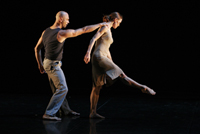Art and activism, protest and ethnographic exploration are central to the current “Printemps du MAI” (Montréal, arts interculturels) programming this month. The work of Montréal-based interdisciplinary artists Mary St-Amand Williamson and Zohar Melinek is part of that roster. He hails from Jerusalem and she from rural Ontario. In Collective Individual, only their second performance together, the duo evoked the duality and the collision that occurs during painful oppression and the subsequent transformations that arise.
It’s over a year since the revolt on the streets of Cairo and the mass movement that ignited in Tahrir Square, but the show’s projected images of a slow-moving convergence of bodies, swelling and gaining power and momentum as it moves forward, still resonate forcefully. In this footage of the Arab Spring of 2012, the camera is a witness. Reality seeps from the screen into the theatrical space. The soundtrack is a rumbling collage of sound, everything from voices rising and falling to the intimate sound of coins dropping and the larger rumble of a crowd pressing forward. And while the indelible stories of the uprising are not replicated or even part of a described narrative, I am reminded how comforting it is to be watching the footage from my secure corner of the word.
What happens outside the purview of the image is what Collective Individual explores to such powerful effect. The MAI stage can be easily be reconfigured, and here the wings are open allowing the broad expanse of space to breathe. When we first see the pair – they are both on the floor – he is rocking back and forth, while she is in a crouched position. In these first moments, Williamson and Melinek appear to be negotiating their own personal space, fingers reaching, arms ramrod straight, gaze shifting inward then outward. They attempt to rise off the floor and then collapse back down. We hear the sound of their rapid inhalation and exhalation. The proximity of the audience to the stage provides another layer of connectivity. Connection (or lack of it) is a constant reference throughout the powerful piece.
Although Williamson and Melinek, who have backgrounds in movement, physical theatre, visual arts and interdisciplinary performance, rarely touch each other throughout the hour-long performance, they are inexorably linked. When they do come together, there is tangible intensity as he rolls over her, and a ferocious intimacy when her hand rubs his face, distorting it visibly. In another section, when he draws her close to him, she is initially impassive to him. But the scene shifts and, in a riveting moment, the weight of resistance in her body becomes more and more pronounced and entirely changes the politics of their encounter. This is a pas de deux in which personal power, stoked by incremental moments of challenge and hesitation, shifts back and forth. In another compelling instance toward the end of the piece they begin to rub their own bodies, pulling at skin and cloth, their hair, their extremities, all this to a constant ambient drone.
What I admired and felt deeply about long after this performance was over was the active engagement and commitment of the performers. As much as it’s a very physical performance, and what’s taking place is intense and driven, there’s a move to a psychic space. The dance appears to be a pulling back from the vulnerable body to an interior realm that I perceive to be a refuge. At the very least the performers are gazing deeply into their own hearts. This transformation seems in contrast to the dangers of embodied life.
Questions surfaced again and again for me while watching this piece: Are there boundaries between theatre/performance and reality? Can political rhetoric and dance rise above artifice? How can a performance be radical and accessible at the same time? In Collective Individual, the artists have devised a way of making the invisible visible. The work is operating on several different levels all at once: the uncertainties of freedom, re-asserting the need to embrace political realities and reinvesting movement with meaning. Self-expression in the face of moral, political and aesthetic matters is not for everyone, but the Melinek-Williamson duo is commanding attention with their whole being. With each sequence – ranging from quiet and reflective to harsh and thrusting – they exercise a visceral investigation.
Tagged: Contemporary, Interdisciplinary, Performance, Montréal , QC





